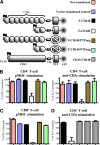The large ectodomains of CD45 and CD148 regulate their segregation from and inhibition of ligated T-cell receptor
- PMID: 23580664
- PMCID: PMC3663424
- DOI: 10.1182/blood-2012-07-442251
The large ectodomains of CD45 and CD148 regulate their segregation from and inhibition of ligated T-cell receptor
Abstract
T-cell receptor (TCR) triggering results in a cascade of intracellular tyrosine phosphorylation events that ultimately leads to T-cell activation. It is dependent on changes in the relative activities of membrane-associated tyrosine kinases and phosphatases near the engaged TCR. CD45 and CD148 are transmembrane tyrosine phosphatases with large ectodomains that have activatory and inhibitory effects on TCR triggering. This study investigates whether and how the ectodomains of CD45 and CD148 modulate their inhibitory effect on TCR signaling. Expression in T cells of forms of these phosphatases with truncated ectodomains inhibited TCR triggering. In contrast, when these phosphatases were expressed with large ectodomains, they had no inhibitory effect. Imaging studies revealed that truncation of the ectodomains enhanced colocalization of these phosphatases with ligated TCR at the immunological synapse. Our results suggest that the large ectodomains of CD45 and CD148 modulate their inhibitory effect by enabling their passive, size-based segregation from ligated TCR, supporting the kinetic-segregation model of TCR triggering.
Figures





References
-
- Weiss A, Samelson LE. T-lymphocyte activation. In: Paul WE, ed. Fundamental Immunology. Philadelphia: Lippincott Williams & Wilkins; 2003: 321-364.
-
- van der Merwe PA, Dushek O. Mechanisms for T cell receptor triggering. Nat Rev Immunol. 2011;11(1):47–55. - PubMed
Publication types
MeSH terms
Substances
Grants and funding
LinkOut - more resources
Full Text Sources
Other Literature Sources
Molecular Biology Databases
Research Materials
Miscellaneous

